Romance and Spring Harvest At Paradise Lot
Air Date: Week of May 10, 2013
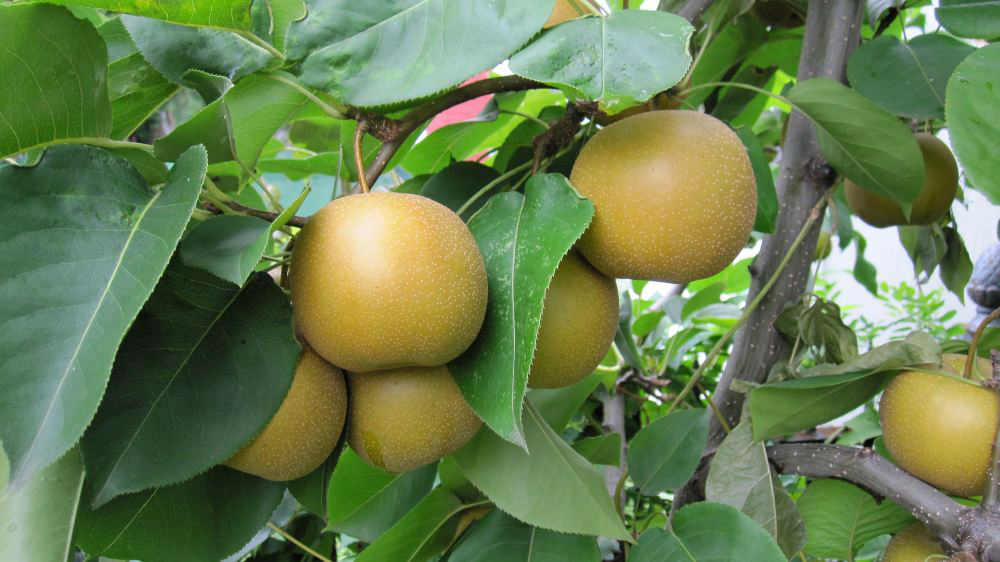
Asian pears growing in Holyoke, MA (Photo: Eric Toensmeier)
For most gardeners, springtime means a time to sow. But for perennial gardeners spring is a time to reap. In their new book, Paradise Lot, gardeners Eric Toensmeier and Jonathan Bates tell their personal stories of finding romance and growing a food forest of perennial plants on a degraded backyard plot. Living on Earth’s Bobby Bascomb took a trip to Holyoke, MA to see and sample their spring harvest.
Transcript
CURWOOD: So at this time of year an alligator's fancy turns to thoughts of love, but in much of the country, a gardener's thoughts turn to seeds and weeds and mulch. For many folks, that probably means not more than a few bedding plants and tomatoes. But for permaculture gardeners Eric Toensmeier and Jonathan Bates, spring is a time of bounty, because that’s when leafy perennial vegetables are already at their prime. Eric and Jonathan’s new book, Paradise Lot, is the true story of their experience building a perennial forest garden in a degraded back yard in gritty Holyoke, Massachusetts. Living on Earth’s Bobby Bascomb went to chomp her way through their garden.
BASCOMB: From the street, this gray duplex doesn’t look like much. But around the back is an urban oasis. The yard is just one-tenth of an acre but produces almost all of the fruits, vegetables, and eggs two families need. Eric Toesnmeir took me on a tour of his garden.

The view from above the gardens. (Photo: Eric Toensmeier)
TOENSMEIER: This is the season of perennial vegetables, vegetables that come back every year and make food. So, down here is Turkish rocket. It looks a bit like a dandelion this time of year but soon it will make these wonderful broccoli rabes, like an 8 or 10 inch mustardy tasting broccoli that are absolutely delicious.
BASCOMB: Eric says what he and his gardening partner Jonathan Bates have created is a permaculture food forest.
TOENSMEIER: So we’re trying to in this area imitate the structure of a forest with trees and shrubs and herbaceous species and vines and fungi but have them be both edible for us and working together as an ecosystem.
BASCOMB: At the lowest level there’s the broccoli - and ramps, ginger and violets. Above them grows a gumi bush, one of their many Asian species. It fixes nitrogen and produces berries that taste a bit like rhubarb. Shading over them all is an American persimmon tree.

A goumi bush fixes nitrogen and provides small red fruits. (Photo: Eric Toensmeier)
TOENSMEIER: Permaculture is meeting human needs while improving ecosystem health.
BASCOMB: Eric says when they bought the house, the yard needed help. All it would grow was crab grass.
TOENSMEIER: We had three different kinds of terrible soil. There was sand and gravel fill and there was a compacted clay with chunks of concrete and rebar in it, and the last piece where we are now was a sandy acid soil with low levels of lead.
BASCOMB: Eric and Jonathan took one look at this barren plot of bad soil and felt inspired.
TOENSMEIER: We actually thought it was perfect. We wanted to be somewhere where the scale at which we were operating was really relevant to lots of people. So we were looking to be in the city. We wanted to find some sweethearts and we felt like we’d have better luck in the city than in the country where we were more likely to run into a bear than a woman. And we wanted a place that was as beat up as you can imagine because we wanted to set the bar high and say, “well, if we can do it then you can totally do it.“
BASCOMB: So what should we look at next?
TOENSMEIER: Oh, let’s visit the chickens then.
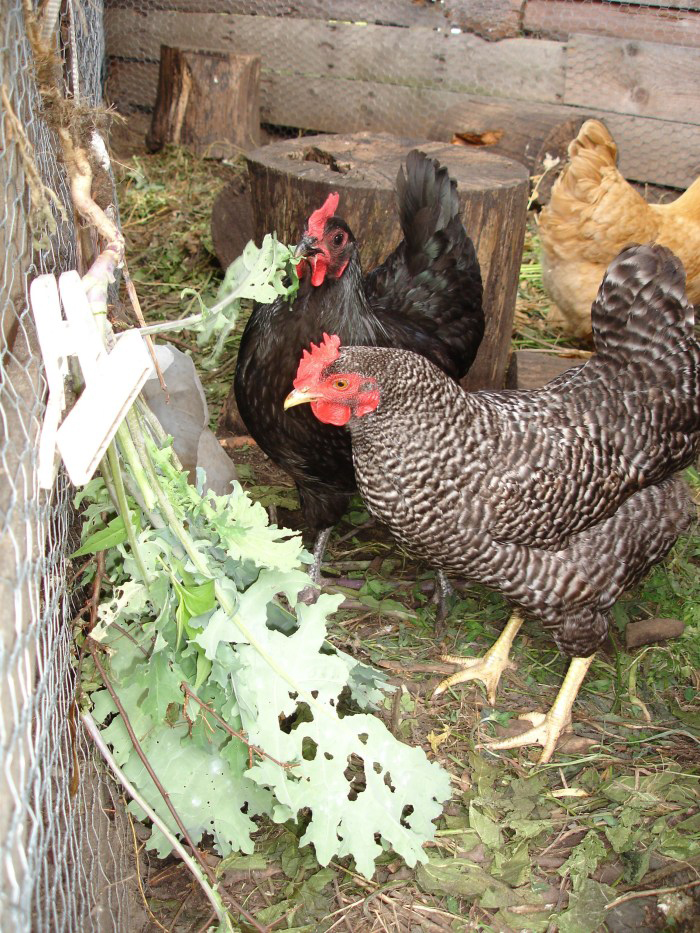
Chickens are an integral component to the health of Paradise Lot. (Photo: Eric Toensmeier)
BASCOMB: Yeah!
[CHICKENS CLUCKING]
TOENSMEIER: So, these are our girls. We have three chickens and they’re a really important part of our backyard ecosystem. We feed them lots and lots of leaves from the garden, excess vegetation both from our own crops and weeds and they love it.
BASCOMB: Eric picks a handful of weeds and feeds them to the chickens through the fence. And he says the bulk of the chickens’ food comes from garden weeds and bugs.
TOENSMEIER: I feel like we wouldn’t really be able to do our garden well without them. It’s so important for them to take the excess biomass that’s produced in the garden and convert it into stuff we can eat directly like eggs and eventually meat, and all this fantastic material that we are standing in right now. The bedding plus manure plus weeds accumulates into a great big deep layer by the end of the year and that is beautiful compost material and they’ve sped up our fertility cycling very dramatically.
BASCOMB: Do you name your chickens?
TOENSMEIER: We don’t.
BASCOMB: Probably a good practice.
TOENSMEIER: Any animal you are going to eat you don’t want to name - unless you name it Christmas or Thanksgiving for the meal at which you will eat it.
BASCOMB: How many eggs do you get a day?
TOENSMEIER: In the summer each one lays one egg. In the winter none of them do. In the spring and fall are sort of in between. They average 220 eggs apiece per year. So, that’s quite a lot. It makes a big difference in our diet.
BASCOMB: Though the chickens are vital, there is a problem.
TOENSMEIER: It’s completely illegal to have chickens in Holyoke. We didn’t have any trouble with them initially and then at one point our previous next door neighbors over here were raided for selling drugs. While the police were here for that they called in our chickens, which is about an equivalent crime of course…three chickens and selling cocaine! So we took them away to the country for a couple weeks until the heat cooled down, and then we brought them back. What we were told if there’s another complaint we would get a $25 fine and we sort of felt like we could live with that alright.
BASCOMB: I would think too you could probably buy off the neighbors with a couple of eggs.
TOENSMEIER: And strawberries. Strawberries are the best bribe we have.

Eric says fresh, organic strawberries are the best bribe they have for neighbors. (Photo: Eric Toensmeier)
BASCOMB: What else should we see now?
TOENSMEIER: Let’s go visit the bamboo grove and the best fruit production area we have in the back corner.
BASCOMB: Sounds good.
[WALKING]
BASCOMB: We walk down the wood mulch path to a corner where tall thin bamboo reeds rustle in the wind. It’s a dense grove that creates a private space in the garden. Next to is the fruit orchard.
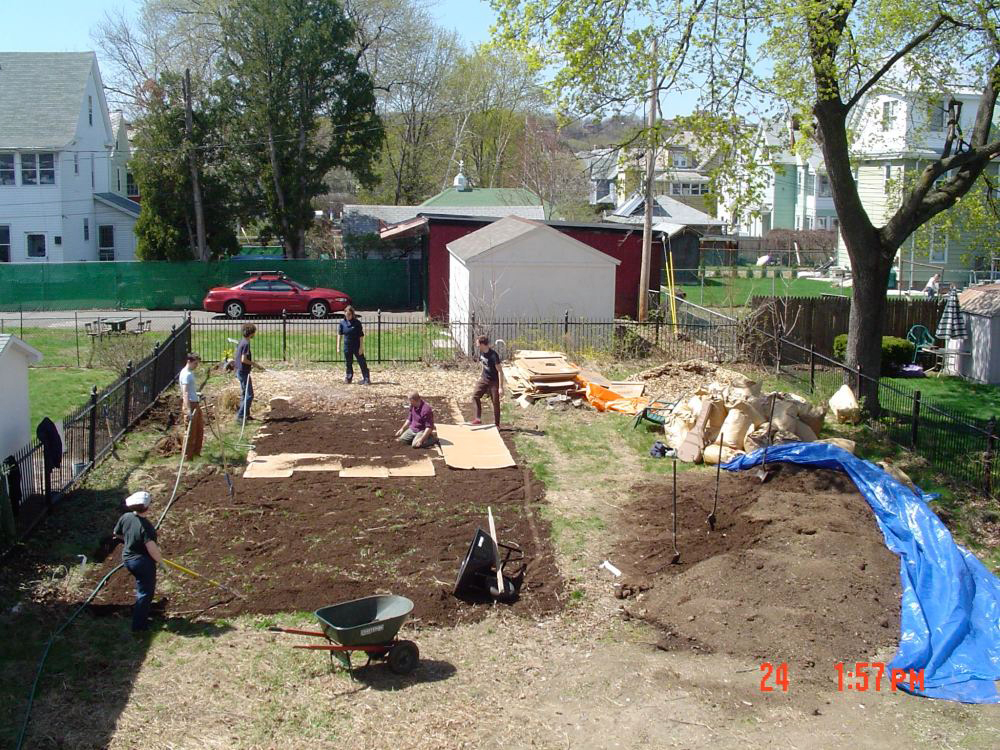
The yard was a blank slate when they bought the house. (Photo: Eric Toensmeier)
TOENSMEIER: This is our Asian pear, it’s just flowering fully for the first time today. We don’t have a lot of room so it’s on a dwarfing root stock that keeps it really small. And it has three different varieties grafted on to it, an early season fruit, a mid season fruit and a late season fruit all on the same tree.
BASCOMB: They get about 150 pears a year, not too shabby for a tree just 12 feet high.
TOENSMEIER: In the same area we have blueberries and service berries, and raspberries, and hazelnuts, and grapes, and rhubarb, and perennial leeks, and elephant garlic, and strawberries so in just this tiny corner which is about 20 by 25 we have all those different plants fruiting and producing excellent food for us.
BASCOMB: Such diversity is impressive and I can’t help but compare it to my backyard garden. The only things I have growing are some pea plants and weeds. But Eric says anyone can create this kind of garden. Just start with something simple.
TOENSMEIER: I think if people are going to start with one thing it would be berries. They don’t take up a lot of space. A lot of them can handle some shade. They’re beautiful, they taste good and they’re mostly very easy to take care of. And every year you can add another bed. We didn’t do all this in one year either.

Old logs do double duty as mushroom habitat and borders for garden beds. (Photo: Eric Toensmeier)
BASCOMB: The garden beds are bordered with old logs. They’re inoculated with spores to grow edible mushrooms but Eric says they also form a critical habitat.
TOENSMEIER: When you roll one over all kinds of creepy crawly things come out which are part of our decomposer ecosystem and they’re part of our pest control system as well. A lot of predacious ground beetles, for example, live under the logs and then go out and eat pests and even eat weed seeds.
BASCOMB: And the system works. In seven years they’ve never had to use pesticides of any kind in the garden. Instead they provide habitat for garden helpers like ladybugs and praying mantises. But, Eric says, it’s wasn’t just beneficial insects that he and Jonathan hoped their garden would attract.
TOENSMEIER: One of our goals for the garden was to attract mates. We felt like the birds that put shiny things in their nest to attract a mate. We planted fruit trees. It’s not like we literally thought that would be all someone was attracted to obviously, but it doesn’t hurt to distinguish you in the market place of other potential mates if there’s something unique and interesting and delicious about you and your backyard.
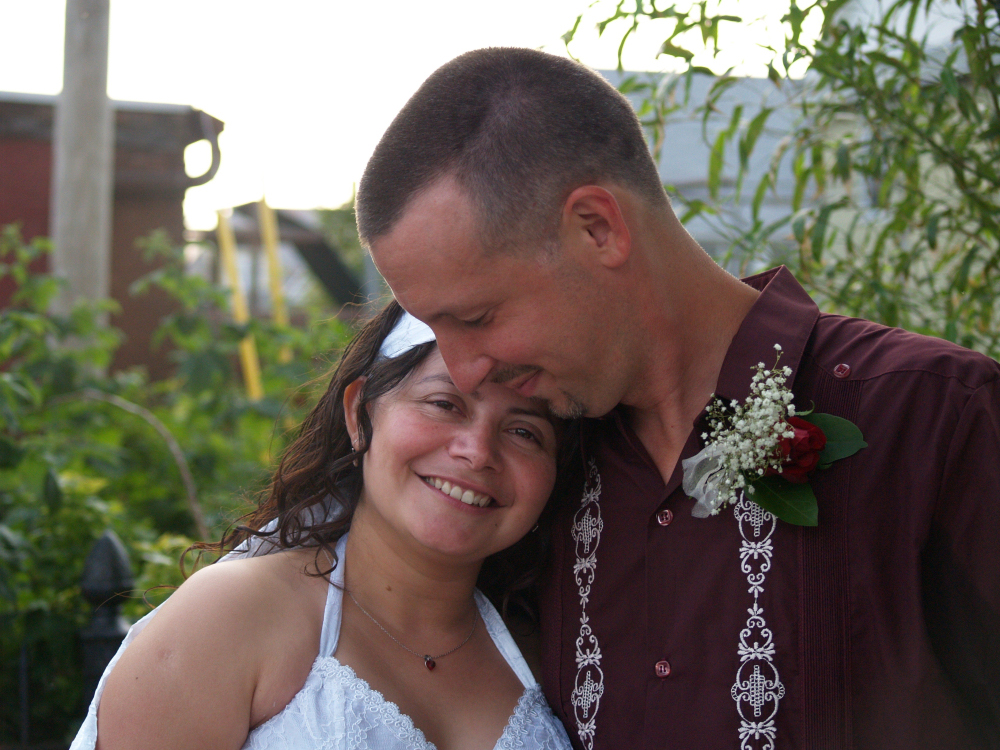
Eric and Marikler were married in the bamboo grove of Paradise Lot. (Photo: Eric Toensmeier)
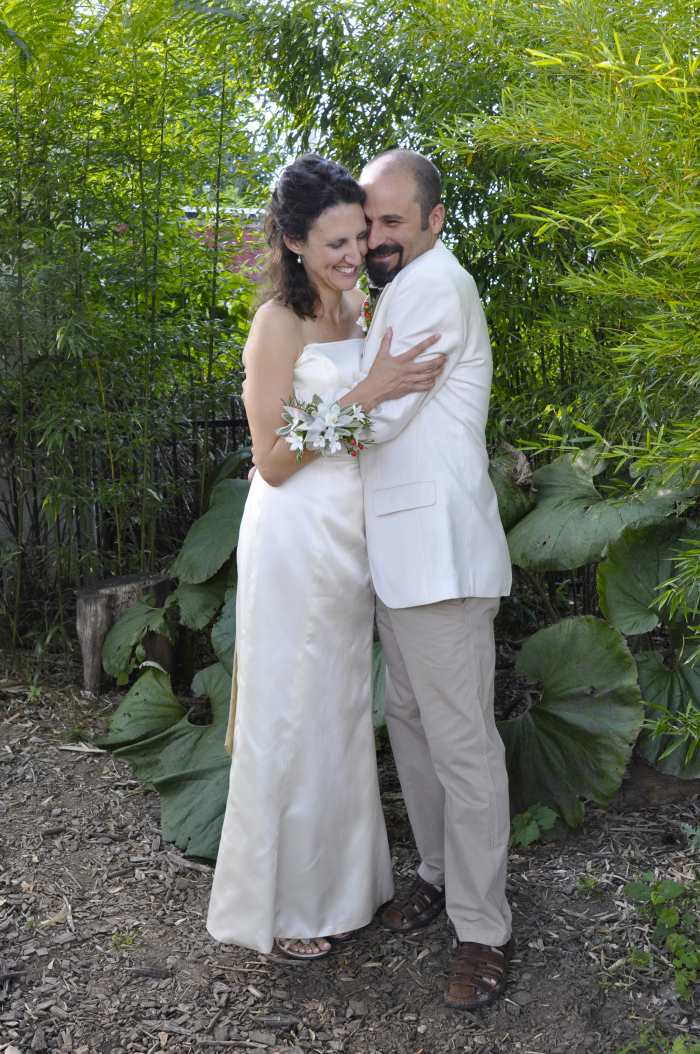
Jonathan and Meg tied the knot at Paradise Lot. (Photo: Eric Toensmeier)
BASCOMB: And that worked too. Next to the bamboo grove beneath a flowering mimosa tree, Eric married Marikler and Jonathan married Meg.
[WIND IN THE BAMBOO]
BASCOMB: As if on cue, Jonathan joins us between the bamboo and the greenhouse.
BATES: My name is Jonathan Bates and I’m a co-gardener here with Eric and landscape. He’s been a mentor for over 10 years now.
BASCOMB: And they’re constantly experimenting. Jonathan designed and built the greenhouse where they grow some annual vegetables and tropical plants.
BATES: We were able to overwinter a hardy avocado and it’s already grown six inches since spring started in there.
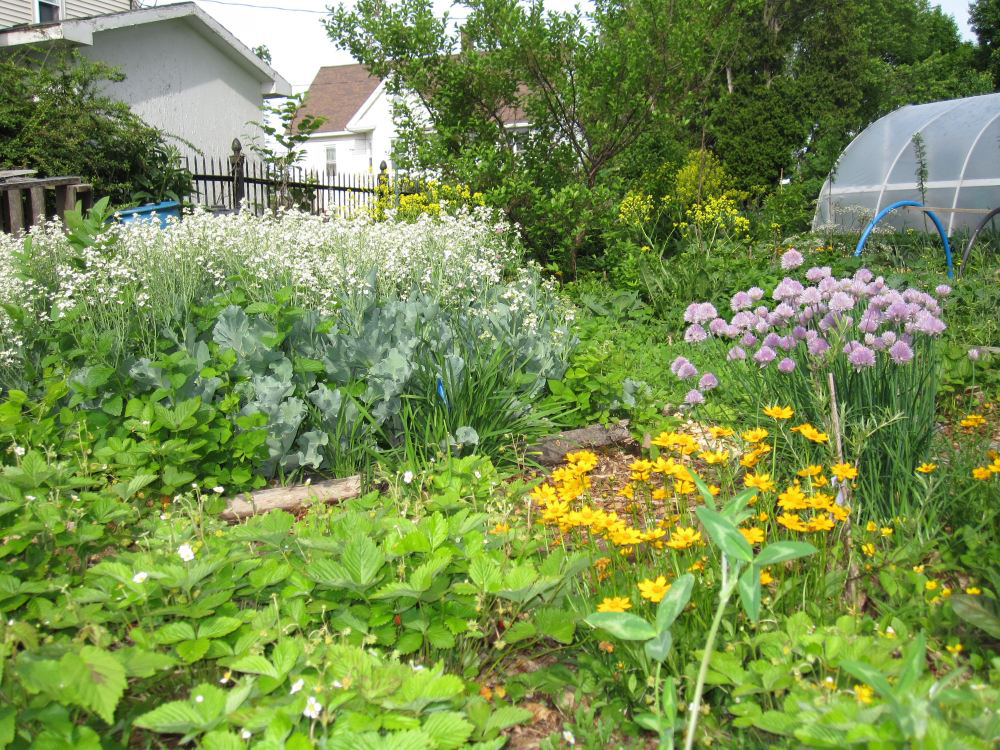
Spring time at Paradise Lot. (Photo: Eric Toensmeier)
BASCOMB: You’re growing avocado in Massachusetts?
BATES: Yeah.
BASCOMB: I’ve got to see that.
BATES: We can go check it out.
BASCOMB: Great.
[WALKING]
BASCOMB: Inside the greenhouse it’s humid and much warmer. Jonathan says walking in here is like going on vacation.
BATES: Instead of spending a couple thousand dollars going to Florida with the family for a week, we invested that money in building this greenhouse and now we’re living in northern Florida. So we have things like citrus, Chilean guava, fig, hardy avocado; these are called tree collards. They get to be 11 feet tall and they are perennial - they grow them all year round.
BASCOMB: Recycled granite curbstones define a raised bed inside the greenhouse. There’s also three large tanks containing an aquaponics system with catfish and 800 gallons of water. Jonathan says the granite and the water collect heat during the day and radiate it back at night to make the greenhouse up to 10 degrees warmer.
[RUNNING WATER, PUMPS]
BASCOMB: They plan to expand the system and grow more fish for food in the future, but right now there are plenty of things ready to eat and they’re eager for me to try them. Jonathan tears out a handful of watercress.
[TEARING WATERCRESS]
BATES: It’s a little spicier now because it’s about to go to flower but we had a good three month run for the watercress.
BASCOMB: Mmm…it’s pretty bitter.
TOENSMEIER: There’s tree collards in here to eat right now but if we come outside we have garlic chives.
BATES: We can get some violet flowers for you.
[PICKING FLOWER FOLLOWED BY FAINT CHEWING SOUND]
BASCOMB: Mmm… they’re sweet.
BATES: Here’s some miner’s lettuce. We don’t have a lot of it but they’re good to eat.
BASCOMB: Oh my gosh, a carrot!
TOENSMEIER: These are real nice. These are last year’s carrots. This is Nantes which is like a sweet dessert carrot.
BASCOMB: A dessert carrot. You talk about it like it’s wine!
TOENSMEIER: We’ve sort of started to become connoisseurs of different vegetables here, which is really fun.
BATES: Do you like sorrel?
BASCOMB: I don’t know.
BATES: Let’s try it.
[CHEWING SOUND]
BATES: So, it’s lemony tart.
BASCOMB: Mmm! It’s tart! [LAUGHS]
BATES: You can tell that we don’t eat a lot of it.
BASCOMB: Yeah, I can see why! [LAUGHS]
BATES: Do you like black licorice?
BASCOMB: Sure.
BATES: This is sweet Cicily.
BASCOMB: Thank you.
BATES: Mostly we grow it for the flowers that bring beneficial insects but this is a traditional sugar substitute in Europe. And then one last thing I can show you is the water celery. It has kind of a parsley celery flavor.
BASCOMB: Thank you.
[CHEWING]
BATES: This is a very popular tropical herb in Asia, Southeast Asia, grown in the water. Here it can grow terrestrially in partial shade.
BASCOMB: That’s a pretty impressive plant.
BATES: Yeah. Did Eric show you the sea kale over here?
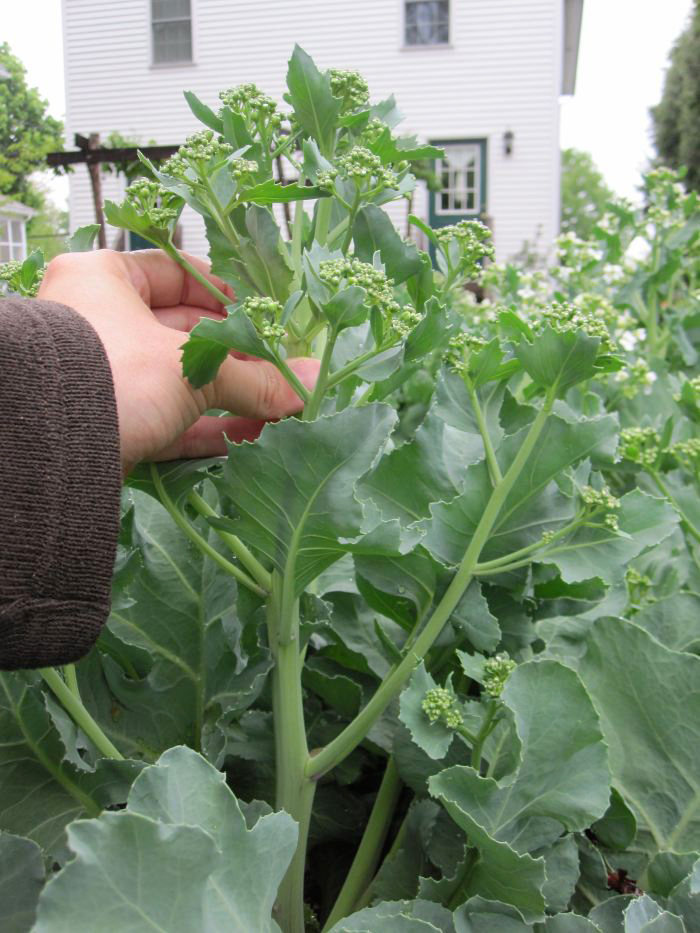
Sea kale is a perrenial plant that tastes like brocoli but more tender. (Photo: Eric Toensmeier)
[WALKING]
BATES: So, you gotta try a floret.
[FLORET CRACKING]
BATES: So, it’s a perennial kale that I think is as good as broccoli, annual broccoli.
[CHEWING]
BASCOMB: Where do you guys get these? I’ve never seen sea kale in my local nursery.
BATES: Originally sea kale was a seed we bought from a seed company way back 10 years ago. So some of these plants are 10 years old. But now if you want to get a sea kale plant you can get them from foodforestfarm.com.
BASCOMB: Is that your company?
BATES: That’s my nursery, yeah. [LAUGHS]
BASCOMB: So, the garden has turned into a business for Jonathan. When they started this project they had simple goals…to walk out in the yard and get a handful of fruit each day of the summer, greens every day of the year, and find the loves of their lives. Mission accomplished on all accounts. Jonathan says he knew the garden was a success after five or six years when the plants really took root and started to produce in abundance.
BATES: There’s an explosion of life really and at that point this idea of mimicking a forest ecosystem really hit home. It’s like, we really did it.
BASCOMB: For Eric, success was being able to share the fruits of his labor and inspire others.
TOENSMEIER: Over a thousand people have come and visited the garden and a lot of them have gone home and done this. They buy plants from Jonathan or we send them home with seeds. Being in the city has been really good for building a movement.
BASCOMB: Eric and Jonathan say they might one day move out of their paradise lot to a larger piece of land in the country but for now they are happy to be here, building a grassroots movement growing anything but grass.
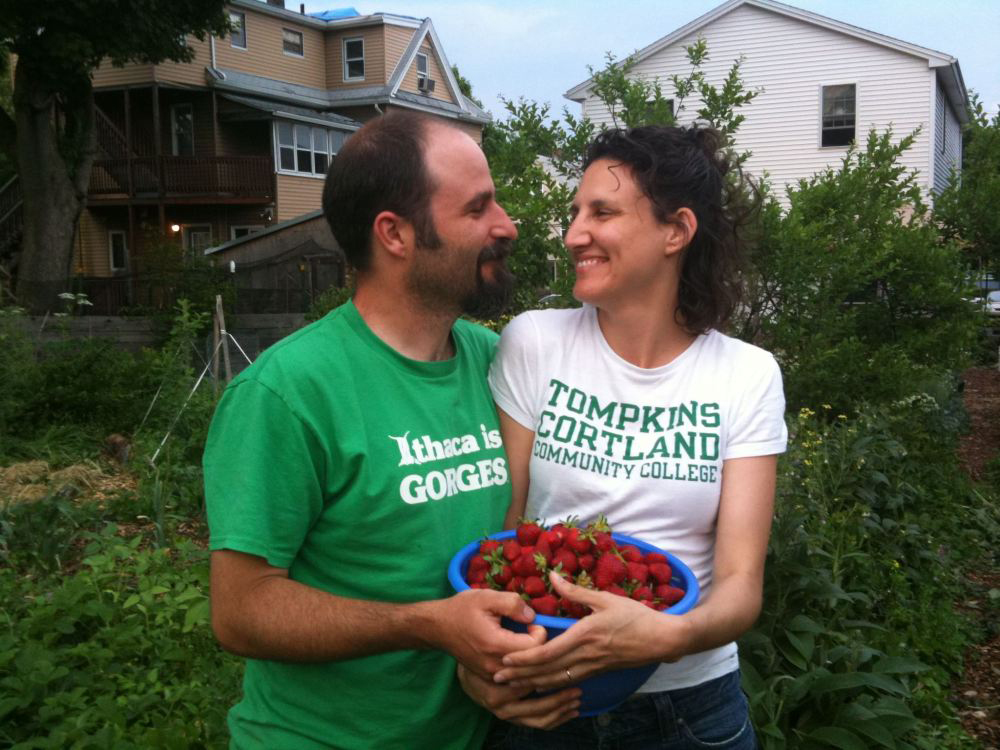
(Photo: Eric Toensmeier)
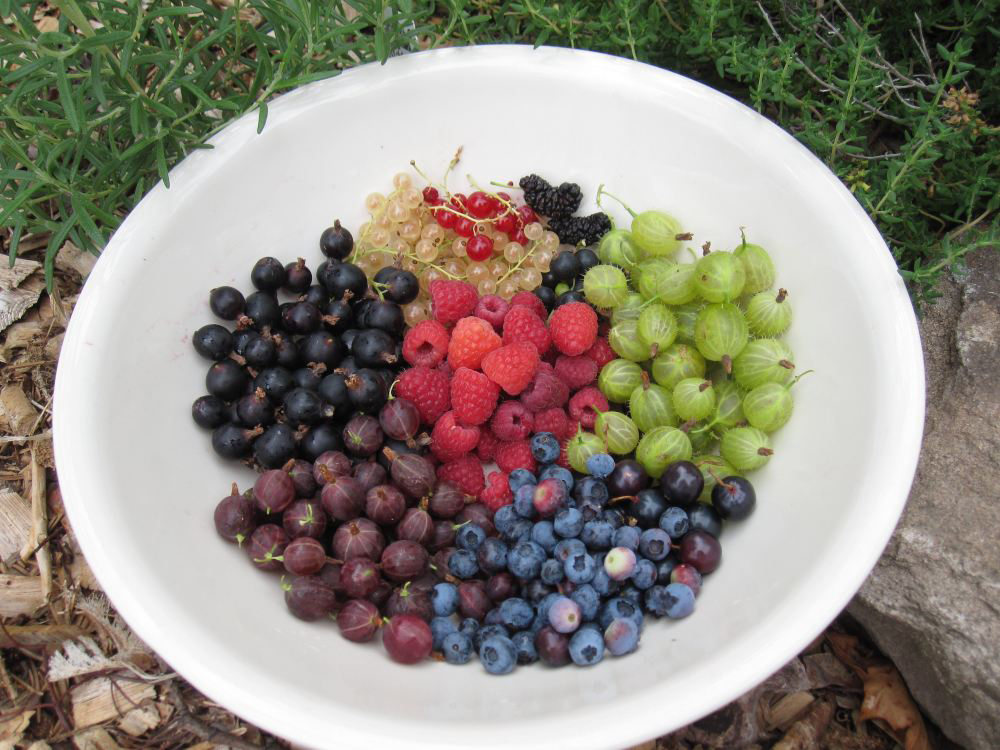
(Photo: Eric Toensmeier)
For Living on Earth, I’m Bobby Bascomb in Holyoke, Massachusetts.
Links
Living on Earth wants to hear from you!
Living on Earth
62 Calef Highway, Suite 212
Lee, NH 03861
Telephone: 617-287-4121
E-mail: comments@loe.org
Newsletter [Click here]
Donate to Living on Earth!
Living on Earth is an independent media program and relies entirely on contributions from listeners and institutions supporting public service. Please donate now to preserve an independent environmental voice.
Newsletter
Living on Earth offers a weekly delivery of the show's rundown to your mailbox. Sign up for our newsletter today!
 Sailors For The Sea: Be the change you want to sea.
Sailors For The Sea: Be the change you want to sea.
 The Grantham Foundation for the Protection of the Environment: Committed to protecting and improving the health of the global environment.
The Grantham Foundation for the Protection of the Environment: Committed to protecting and improving the health of the global environment.
 Contribute to Living on Earth and receive, as our gift to you, an archival print of one of Mark Seth Lender's extraordinary wildlife photographs. Follow the link to see Mark's current collection of photographs.
Contribute to Living on Earth and receive, as our gift to you, an archival print of one of Mark Seth Lender's extraordinary wildlife photographs. Follow the link to see Mark's current collection of photographs.
 Buy a signed copy of Mark Seth Lender's book Smeagull the Seagull & support Living on Earth
Buy a signed copy of Mark Seth Lender's book Smeagull the Seagull & support Living on Earth

